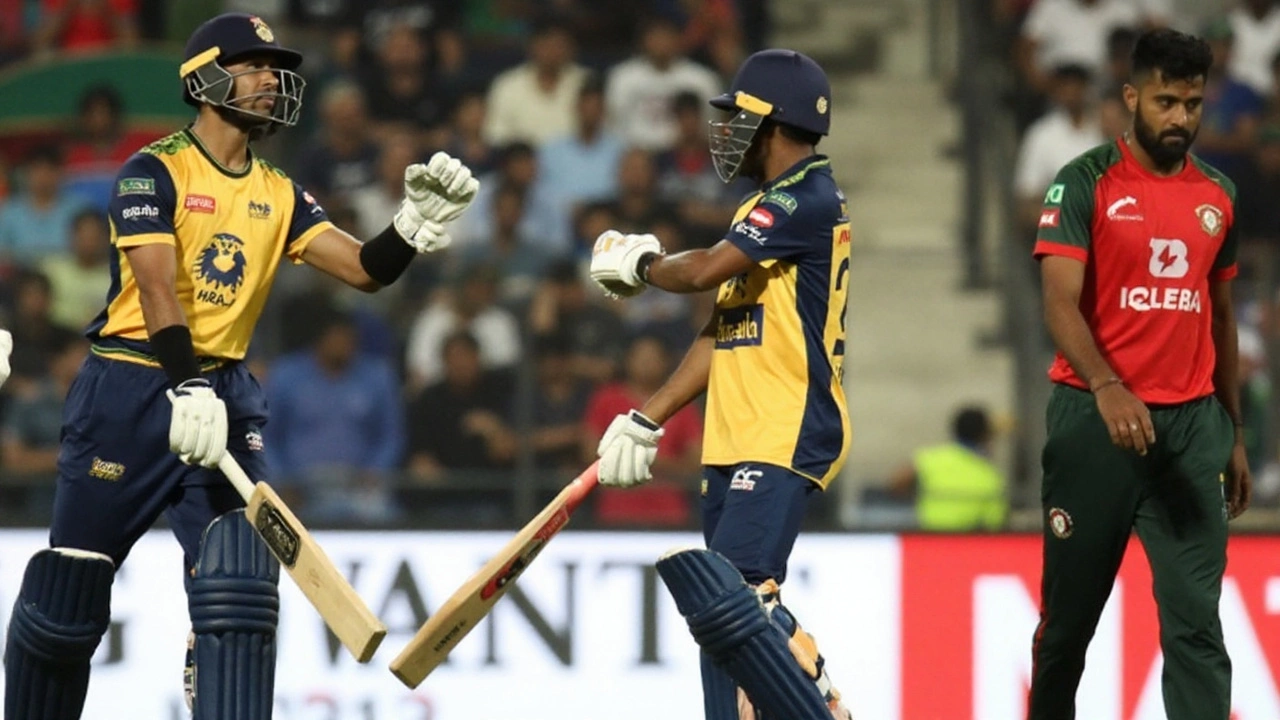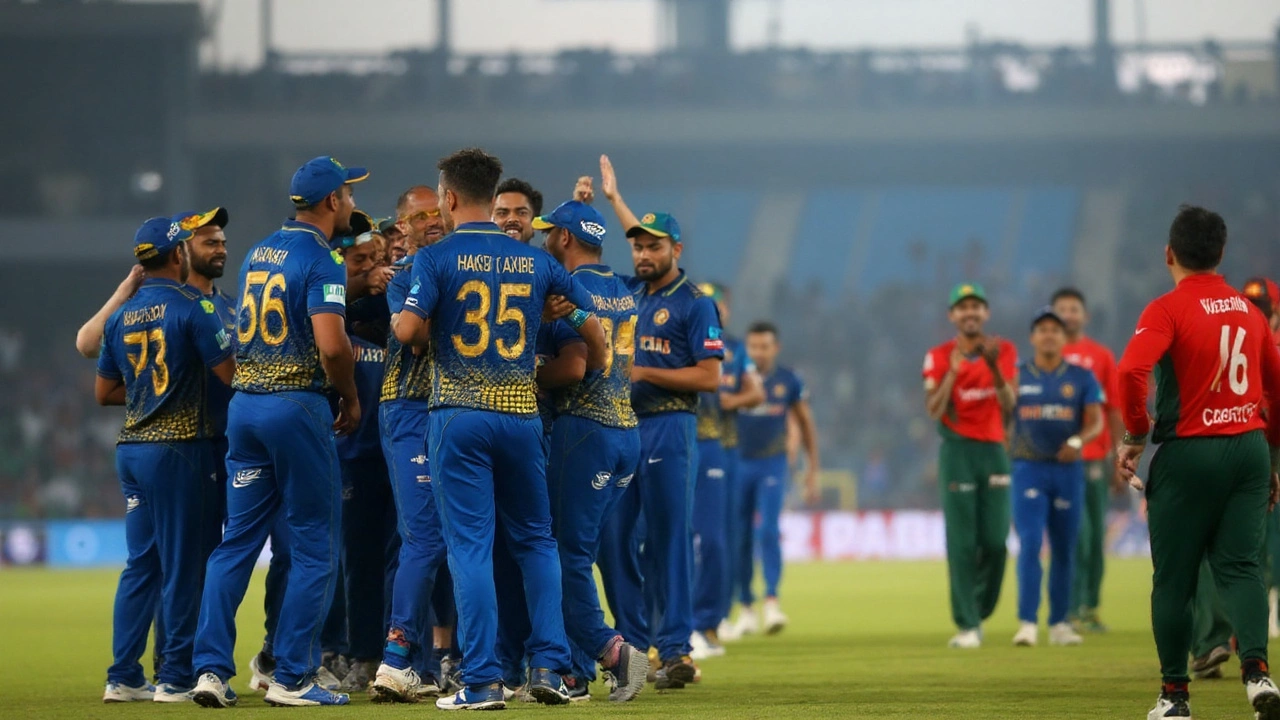
Sri Lanka didn’t just win; they set the tone for Group A. In their first outing of the tournament, they crushed Bangladesh by six wickets and closed the chase before the 15-over mark in Abu Dhabi. Bangladesh arrived with a win over Hong Kong behind them. They left with a reminder that this Sri Lanka side, when the ball and plans click, moves fast and leaves little to chance.
Sri Lanka squeeze first, then surge: the bowling blueprint
Charith Asalanka’s first big call was to bowl. On a night when the surface offered just enough grip early and the breeze kept cross-seamers honest, it was the right read. Sri Lanka’s new-ball pair hit a hard length, kept the stumps in play, and starved Bangladesh of easy drives. Dot balls stacked up in the powerplay, and the asking rate for the batters—mentally, if not mathematically—started to climb.
The plan was clear: Dushmantha Chameera to pound the deck, Matheesha Pathirana and Nuwan Thushara to vary pace and angles, and the support cast to close off singles in the ring. It looked simple because they executed it well. Bangladesh’s top order—Parvez Hossain Emon, Tanzid Hasan Tamim, and captain-wicketkeeper Litton Das—couldn’t stitch a steady stand. Every time they found a boundary, Sri Lanka’s reply was a string of dots or a change-up that reset the momentum.
The middle overs brought more of the same. Any attempt by Towhid Hridoy or Jaker Ali to rebuild ran into tight lines and well-placed sweepers. When Wanindu Hasaranga came on, he didn’t need to be spectacular; he just needed to keep the squeeze. With seam at both ends and spin locking one, Bangladesh were stuck toggling between risk and retreat.
Pathirana and Thushara are awkward in different ways—slings, pace off, and those skiddy wide lines that make big hits tough at Abu Dhabi. They teased the big shot and then dragged length or took the pace away. Bangladesh’s attempt to counter with lower-order power, through Mahedi Hasan and Rishad Hossain, never quite took off. The result was a modest total that felt 15–20 short in the conditions, especially against a batting unit that’s been in good touch this season.
- Powerplay control: line at the top of off, hard length, minimal freebies.
- Middle-overs choke: spin used to hold one end while seamers rotated.
- Variation clinic: slower-ball bouncers, wide yorkers, and angled seams to deny rhythm.
- Tight fielding: one-out saving in the ring, sharp boundary riding to turn fours into twos.
For Bangladesh, the frustration showed in the lack of strike rotation. Singles dried up, which made boundaries feel compulsory. That’s when errors crept in—reaches outside off, miscues into the deep, and soft dismissals that left the innings without a finishing kick.

Measured chase, fast finish: Mendis and Nissanka set the tone
If the ball was Sri Lanka’s statement, the bat was their signature. Pathum Nissanka and Kusal Mendis walked out with a simple brief: take the sting out of the new ball and punish anything loose. Against a left-arm-led pace attack (Shoriful Islam) and Mustafizur Rahman’s cutters, they didn’t play for highlight reels. They played the percentages—open the face through point, ride the bounce behind square, and cash in when the length slipped too full.
The powerplay came and went with Sri Lanka ahead on tempo without taking risks. Bangladesh needed early wickets to stir panic and open the game. They didn’t get them. Every over without a strike added pressure on the bowlers, and every crisp Nissanka push or Mendis tuck signaled control.
Once set, Mendis shifted gears—picking up the slower ball early and targeting the gaps over midwicket and extra cover. Nissanka’s role was the glue, all timing and angles. With that platform, Sri Lanka could flex. Kusal Perera slotted in to keep the tempo high, and Asalanka, true to his call at the toss, kept the chase brisk. Even a brief twist—Dasun Shanaka’s short stay that ended after three balls—didn’t alter the outcome. Sri Lanka were already cruising at 126 for four, and a clean strike over the infield soon pushed them to the brink, before they sealed it well inside the 15th over.
Chasing this quickly matters. In a group that features Afghanistan’s bowling and Bangladesh’s grit, net run rate can decide who finishes on top. By getting it done with six wickets in hand and plenty of deliveries unused, Sri Lanka banked more than just two points—they banked a buffer for the week ahead.
Bangladesh did search for openings. Mustafizur worked his cutters into the pitch, Shoriful angled it in at the pads from over the wicket, and Rishad Hossain tried to tempt with legspin. The issue wasn’t intent; it was timing. The breakthroughs didn’t arrive in the powerplay, so Sri Lanka weren’t forced into a rebuild. Without scoreboard pressure, the target melted away.
Under lights in Abu Dhabi, this is the modern T20 pattern: win the toss, chase with a plan, and let disciplined new-ball bowling set the tone. Asalanka’s call matched the evening’s feel. The surface held true, the outfield ran quick, and dew talk—whether heavy or light—wasn’t even needed. Sri Lanka simply out-executed.
So what did we actually learn beyond the scoreline? First, the seam trio of Chameera, Pathirana, and Thushara give Sri Lanka three distinct looks: hit-the-deck pace, slingy pace-off variation, and a right-armer who can tail it at the stumps. That’s misery for batters trying to line things up. Second, the top order looks settled. Mendis guiding and Nissanka anchoring is a pairing Sri Lanka will back in tight chases too. Third, the fielding was sharp—no sloppy overthrows, no lost chances that drag a dogfight out of a game that’s already yours.
For Bangladesh, the roadmap is clear. They need a stronger first six with the bat and a way to force mistakes early with the ball. Litton Das’s side has the talent—Towhid Hridoy can finish, Rishad can grab middle-overs wickets, Mustafizur can break partnerships. But they need the start that lets those strengths show. Without that, it becomes an uphill sprint every time.
Group A remains spicy. Afghanistan will test Sri Lanka’s batting with seam and spin, while Bangladesh still have paths to the next phase if they get back to the basics that worked against Hong Kong. One result doesn’t define a campaign, but this one does frame it. Sri Lanka have clarity. Bangladesh have adjustments to make.
The headline won’t change, though: a six-wicket win, chase completed inside 15 overs, and a launch that puts Sri Lanka’s campaign on a firm track at the Asia Cup 2025. The performances had all the ingredients coaches love—discipline, repeatable plans, and calm under lights. Keep those, and nights like this become habit.

Write a comment